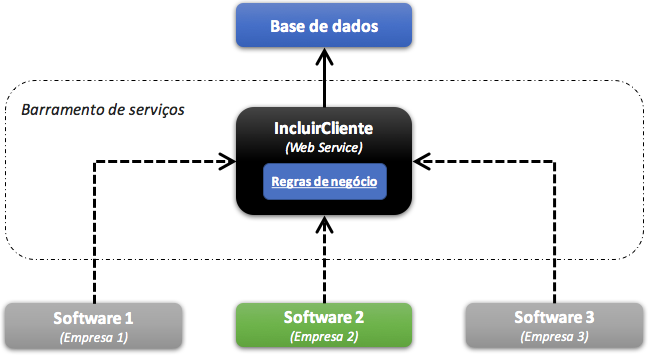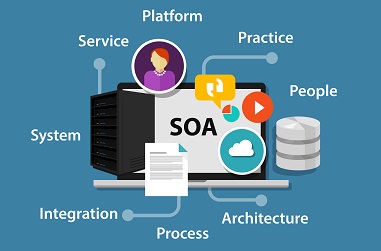Every time we think about a business as a corporate environment, composed of several niches in the same environment (HR, Commercial, Inventory, Production among other areas), surrounded by applications and business systems that aim for growth and the good result of the organization as a everything. It’s easy to see the need to have all the information integrated so the business works well and deliver results.
But how to integrate the applications and systems of the organization allowing access to information in real time if the applications and systems were developed by totally different people and technologies?
I present the ideal scenario for using the SOA architecture.
Did you identify yourself? So follow us because we have fantastic things to reveal to you.
The concept of SOA was first proposed in 1996 in the article “Service Oriented Architectures” (April 1996), written by researchers Roy Schulte and Yefim Natis of the Gartner Group.
They presented it based on the analysis of the experiences of several clients who, at the time, used client-server technology (in strong adoption in those years), and which gained new attention due to the new technological possibilities based on standards, the increasing demand for integration solutions and the relative failure of other alternatives.
So, WHAT IS SOA?
SOA (Service Oriented Architecture) is a concept. It is a design style that guides all aspects of creating and using business services across the entire development lifecycle (from the conception to the retirement of services), as well as addressing the definition and provisioning of the infrastructure – IT infrastructure that allows different applications to exchange data and participate in business process independent of the operating systems where these applications are running or programming languages used for their implementations.
SOA only suggests, proposes and defines. That is, based on your concept you develop solutions like Web Service for example.
Although the concept of SOA is very good to implement in our projects, SOA can not be seen as something that should be used in any project or in any way. This is why SOA is an ideal solution for companies that have large distributed systems as it provides flexibility, scalability and fault tolerance.
Let’s look at a good case of success, provided by SOA-Consortium, of SOA deployment in an organization.
The case that we will use is that of VALERO ENERGY, which is an energy company and has adopted the SOA architecture to address its needs for oil and gas changes due to limitations in access to reserve and remote exploration opportunities, as well as the resulting risks of market volatility.
The strategy adopted was to execute short cycles of acquisitions of new companies, rapidly increasing its presence and its value chain through M & A (Merge and Acquisition) strategies.
The goal in using SOA was to minimize cost and forced separations, in addition to reducing integration cycles from 6 months to 2 to 8 weeks. As a result of using Service Oriented Architecture, Valero Energy achieved flexibility and speed in changing business processes.
Examples include:
- Customers started to get the price quickly at the terminals;
- Risk mitigation and business optimization, for example, accuracy in business, financial and value-for-money data;
- Reliability in the system by simplifying interfaces by reducing data redundancy.
There is something that I believe to be very important to reinforce and keep in mind is that SOA is focused on business processes. These processes are performed through different stages (also called activities or tasks) in different systems. The primary goal of a service is to represent a “natural” stage of business functionality. That is, according to the domain for which it is provided, a service must represent a self-contained functionality that matches a real-world activity. In other words, business people should be able to understand what a service does and IT staff understand that it’s time to not just stay in the technical area and move in to participate in the business as well.
SOA Benefits
A number of benefits are expected in using SOA as:
- Ease of Maintenance: changes in business logic (implementation) do not affect existing applications;
- Reuse: new applications and processes (service consumers) can more easily reuse existing functionality;
- Flexibility: Back-end systems and infrastructure can be replaced with less impact;
- Result: agility and cost reduction;
- Quality: guarantee of homogeneity of processes;
- Less time: agility in the analysis of impact and in the evolutionary development of its systems;
- Lower cost: reduction of the cost of maintenance of the applications;
- Control: knowledge of existing assets.
Among the benefits of using SOA, we highlight the “low coupling of services” that, in practice, means minimizing the impact of modifications and failures within a system scenario as a whole.
Let’s go back to the example at the beginning of the article?
Imagine that you are part of a large company and it has a multitude of softwares that make the company work. Each of these software is maintained by a different service provider and, even worse, each of these software was written in a different language.
Let’s assume you need to share customer data between these applications and your organization has a number of validations that need to be performed before allowing a new client to be entered, and it is mandatory for all software to perform these validations correctly.
As quoted, this is the perfect scenario for using the SOA architecture as we have business assets involved in a completely heterogeneous environment. And everyone needs to talk to each other.
Thinking about a service-oriented architecture, we could solve this very easily. We could create a web service called “IncludeClient”. This web service will be responsible for doing all the validations of the client before entering in the database. Thus, it would be up to other software simply to consume this service in the proper way.

In this way, the chaotic scenario ceases to exist and peace begins to reign and with praise. This is because:
- The software had only to access this web service to insert some client in the base;
- The flow of business was guaranteed;
- We guarantee the reusability and extensibility of the web service by other services / applications;
This is the SOA architecture!
Well, I’ll stop here.
Doubts? Contact.
Strong hug.
Eduardo Santana.
bufallos@bufallos.com.br

